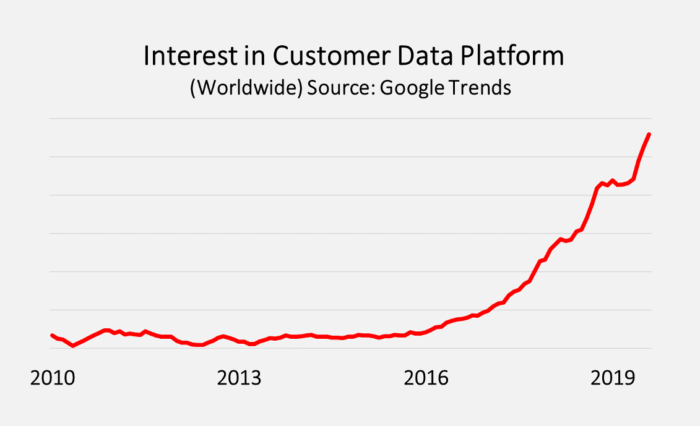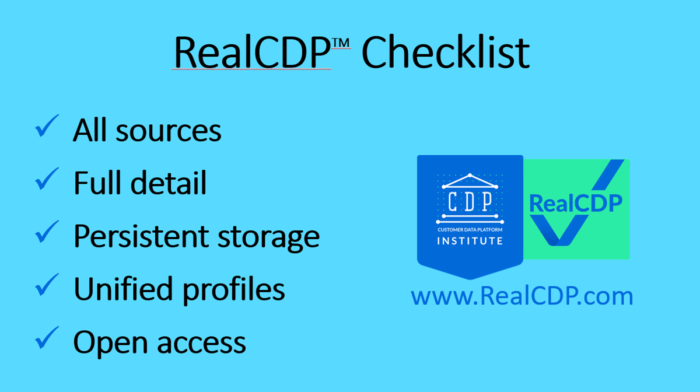Customer Data Platforms (CDPs) came a long way in 2019 and they are going from strength to strength. So what's in store for them in 2020?
2019 was a pivotal year for the Customer Data Platform industry. It experienced a number of important events, including:
- The continuation of rapid growth that saw revenue near €1 billion, new funding exceed €400 million, and the number of vendors increase by 40%.

- The industry saw its first big wave of consolidation, including:
- Acquisitions of CDP vendors by enterprise technology firms (Mastercard bought SessionM, Dun & Bradstreet bought Lattice Engines, Informatica bought Allsight, Acquia bought AgilOne).
- Acquisitions by CDP vendors of other firms (Amperity bought Custora, Leadspace bought Reachforce, Netcore bought Boxx.ai, Manthan bought RichRelevance).
- Asset sales by CDP vendors who couldn’t survive independently (Radius, Stride, Mintigo, IgnitionOne).
- Industry analysts including Gartner and Forrester overcame their initial skepticism and started covering the category.
- Major marketing technology providers launched or promised their own CDP products (Salesforce, Adobe, Oracle, Microsoft, Teradata, SAP, SugarCRM).
- Specialized software vendors embedded CDPs within CRM or other operational systems (Gainsight, Totango, Healthgrades, SmarterHQ, BlueCore).
- CDP vendors increasingly distinguished between systems that focus primarily on assembling the customer database to enterprise-wise use and those that offer extended marketing functions such as predictive analytics and personalization.
Taken together, these events show that CDP has become an accepted part of the technology landscape. Buyers who had barely heard the term a few years ago now believe they need a CDP – even if they’re still not quite clear what a CDP does.

Indeed this lack of clarity is the next great hurdle that CDPs must overcome. For example, one survey (Getting Customer Data Management Right, Forrester Consulting, November 2019) found that 89% of companies say they have a CDP but just 11% use it for the CDP’s core purpose of creating a complete customer profile. Excitement about CDPs will quickly collapse into disillusionment unless marketers build a sound understanding of how to use their CDPs effectively.
CDP Definition
Before we jump ahead to discuss using CDPs, let’s take a step back to define what they are. The Customer Data Platform Institute says a CDP is “packaged software that builds a unified, persistent customer database that is accessible to other systems”. The key points of that definition include:
- Packaged software: The CDP is a product you can buy, not a project that’s custom-built by your IT department or an outside agency.
- Unified, persistent customer database: The CDP takes data from all sources (“unified”), stores it for as long as you want and are legally permitted (“persistent”) and organizes it to create a complete profile for each customer (“customer database”).
- Accessible to other systems: Data in the CDP can be shared with any other system that needs it, usually in real-time through an API.
The CDP Institute summarizes these in a five-point “RealCDP” checklist: ingest all sources, retain full detail, persistent storage, unified profiles, and open access.

Key use cases
The definition matters because CDPs are offered as a solution to businesses’ pressing need to give customers a unified, personalized experience. Delivering this experience requires access to complete, current customer data – that is, the unified, persistent, accessible customer database created by a CDP. Here are some key use cases:
Immediate updates to retargeting lists
A company wants to send display and social ads to website visitors who fail to complete a purchase but then stop the ads immediately if a purchase is later completed. This requires ingesting data from e-commerce and retail systems, attaching it to the correct customer’s profile, and updating the audience lists in the advertising systems. Systems that cannot incorporate all data sources may not be able to assemble and share the necessary data.
Recommend next best action to customer support agents
A company wants to offer optimal treatment to each customer when they call for service. This might mean offering renewal incentives only to customers who are otherwise likely to quit, being strict with customers who make excessive returns, or being generous with long-term customers who rarely make a complaint.
This requires accessing the complete customer history and running predictive models at the time of the interaction. Achieving this reliably requires copying the data into a separate, persistent database because the source systems may not retain the full history or may not be able to retrieve it quickly enough to support a real-time interaction.
Cross-channel orchestration
A company wants to send each customer the right message on the right channel at the right time. This requires gathering data from all sources, running predictive models and business rules to determine the right action, sending the right action to the right channel, and recording the results. A system that cannot select the best actions centrally and distribute them to all channel systems cannot deliver this solution.
Systems that are limited to a few data sources, don’t store their own data, or don’t connect with any channel system can’t support these and many other CDP use cases. If such systems are (inaccurately) called CDPs, then their failures are (inaccurately) seen as CDP failures. This is bad for the CDP industry. Much more important, it’s also bad for the companies that purchased these systems expecting they would support those use cases and later find they cannot. So getting the CDP definition right – and looking for systems that meet the definition – really does matter.
Download our Individual Member Resource – Content marketing strategy guide
This guide shows you both how to develop a strategy to deploy content across all your online marketing and gives practical tips to make it happen.
Access the Content marketing strategy guide
Deployment best practices
Of course, buying a true CDP is just the first step towards success. Other keys to deploying a CDP effectively include:
Connected systems
Source systems must be to provide data to the CDP and destination systems must be able to access the CDP data store. These are especially likely to be issues with legacy software that wasn’t designed to exchange data with other products. CDP buyers should check in advance that their source and destination systems support the connections needed for their desired use cases. Otherwise, they are likely to find the CDP doesn’t deliver the expected benefits.
Data quality
Data within the source systems often isn't suitable for the expected uses. Operational systems often contain outdated, incomplete, or inconsistent data that is adequate for their own operations but causes problems when it’s used for analysis, identity matching, or personalization. Again, it’s important to identify these issues in advance so buyers can make a realistic plan for achieving CDP-based benefits.
Privacy and security
Customer data is increasingly subject to strict regulations on how it is acquired, stored, and used. Some CDPs have special features for compliance with privacy regulations, such as consent management modules. Others rely on users to configure the necessary processes or to run them outside the CDP.
The processes required to deploy a CDP overlap substantially with processes required for privacy compliance, such as identifying all systems that store customer data, linking all data related to the same individual, and making it easy to share, change, or delete each person’s information. So a properly deployed CDP can be a major contributor to compliance projects.
Organizational readiness
Many CDP use cases require cooperation across departments (marketing, sales, service, IT) or within a single department (email, website, advertising). If these groups are not used to working with each other, there may be considerable resistance to making a change. As with other obstacles, it’s important to identify these challenges in advance so you can build plans to address them.
Drive adoption
A CDP is a major corporate resource. Unified customer data has almost infinite applications, but these will only be achieved if potential users understand what the CDP makes possible and how to access those capabilities. Many companies set up a centre of excellence to help users throughout the organization set up their initial CDP projects. Others assign product evangelists, run broad training programs, or build CDP use into business goals.
Measure results
One of the best ways to encourage CDP adoption is to show the success of past efforts. This justifies the initial and on-going CDP investment. Measurement is also essential to improving the results of CDP-based programs through testing and optimization over time. Fortunately, measurement is itself one of the main CDP use cases, so the CDP itself makes measurement easier.
Final thoughts
Above all, CDP success depends on learning to build successful customer experiences. Today’s consumers demand a delicate balance of personalization, convenience, efficiency, control, and privacy. The unified, complete, accessible data provided by CDP makes it easier to deliver this balance, but it’s still up to marketers and others throughout the organization to design the right experiences and execute them effectively.
Marketers who focus on delivering great experiences will find they naturally develop into effective CDP users. Marketers who don’t focus on customer experience will find that even the most skillful CDP use creates little long-term value.
David M. Raab is the founder and CEO of the
Customer Data Platform Institute, a vendor-neutral organization that helps companies make the best use of their customer data. You can
follow him on Twitter or
connect with him on LinkedIn.










